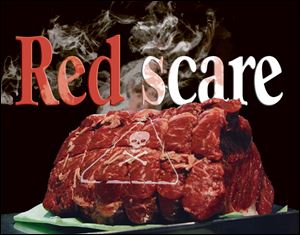
Red meat mortality study leaves many carnivores unfazed
3/26/2012
Tell people seatbelts save lives and most buckle up.
Tell them cigarettes kill and smoking rates go down. But new warnings about red meat don’t seem to cry out with the same urgency.
Phil Neff of Lee’s Summit, Mo., heard about the new study recently, and by noon he was sitting in Arthur Bryant’s BBQ chomping down a beef and pork combo.
“I’m having my meat, I don’t care,” said Mr. Neff, 50.
His buddy across the table, Gary Cowen, 52, in town from Chicago for the NAIA basketball tournament, with mouth full held up two fingers.
Swallow.
“Second time in 12 hours,” he said, referring to their barbecue intake.
The new study released by the Harvard School of Public Health found that eating red meat — any amount and any type — appears to significantly increase the risk of premature death.
The long-range study examined the eating habits and health of more than 110,000 adults for more than 20 years.
For instance, adding just one 3-ounce serving of unprocessed red meat to one’s daily diet was associated with a 13 percent greater chance of dying during the course of the study.
Even worse, adding an extra daily serving of processed red meat, such as a hot dog or two slices of bacon, was linked to a 20 percent higher risk of death during the study.
“Any red meat you eat contributes to the risk,” said An Pan, a postdoctoral fellow at the Harvard School of Public Health in Boston and lead author of the study, published in the Archives of Internal Medicine.
Crunching data from thousands of questionnaires that asked people how frequently they ate a variety of foods, the researchers also discovered that replacing red meat with other foods seemed to reduce mortality risk for study participants.
Eating a serving of nuts instead of beef or pork was associated with a 19 percent lower risk of dying during the study. The team said choosing poultry or whole grains as a substitute was linked with a 14 percent reduction in mortality risk; low-fat dairy or legumes, 10 percent; and fish, 7 percent.
Previous studies had associated red meat consumption with diabetes, heart disease, and cancer, all of which can be fatal. Scientists aren’t sure exactly what makes red meat so dangerous, but the suspects include the iron and saturated fat in beef, pork, and lamb, the nitrates used to preserve them, and the chemicals created by high-temperature cooking.
The Harvard researchers hypothesized that eating red meat would also be linked to an overall risk of death from any cause, Mr. Pan said. And the results suggest they were right: Among the 37,698 men and 83,644 women who were tracked, as meat consumption increased, so did mortality risk.
Almost 24,000 people died in the two studies. Of those, 5,910 were from heart disease and 9,464 from cancer.
In separate analyses of processed and unprocessed meats, the group found that both types appear to hasten death. Mr. Pan said that at the outset, he and his colleagues had thought it likely that only processed meat posed a health danger.
Carol Koprowski, a professor at the University of Southern California’s Keck School of Medicine who wasn’t involved in the research, cautioned that it can be hard to draw specific conclusions from a study like this because there can be a lot of error in the way diet information is recorded in questionnaires, which ask subjects to remember past meals in sometimes grueling detail.
But Mr. Pan said the bottom line was that there was no amount of red meat that’s good for you.
“If you want to eat red meat, eat the unprocessed products, and reduce it to two or three servings a week,” he said. “That would have a huge impact on public health.”
A majority of people in the study reported that they ate an average of at least one serving of meat per day.
The American Meat Institute was among the first to dispute the findings. In a statement, the industry group criticized the Harvard study for “relying on notoriously unreliable self-reporting about what was eaten and obtuse methods to apply statistical analysis to the data.”
The U.S. Department of Agriculture says Americans eat less beef today. The intake peaked in 1976 with a per capita consumption of 89 pounds. By 2000, the amount dropped to 64 pounds, as chicken consumption rose swiftly, to 50 pounds.
Some of those cautionary reports about red meat must be sinking in.
Still, some people seem quite willing to blow off the warnings. Probably in part because you can get a ticket for no seat belt, and most cities have no-smoking ordinances.
How bad can red meat be if there’s no law against it?
And everybody knows someone like Barbara Thornton. She’s 83 and had lunch the day the study was released at Gates Bar-B-Q in Kansas City.
“I eat it all the time, don’t bother me,” she said.
Coming out of Bryant’s, Tyson Johnson, in town from Nacogdoches, Texas, waved off talk of the study.
“Guess what, everybody’s going to die of something,” he said on the sidewalk. “I’ve been eating meat every day for 63 years. And I knew a guy who never ate meat, and I went to his funeral.”
Back inside, Mr. Cowen from Chicago, turned philosophical by citing the old saying that you are what you eat.
“I don’t want to be tofu,” he said.
Mr. Neff used a last fork of meat to chase sauce around his plate.
“I don’t even know what tofu is,” he said.